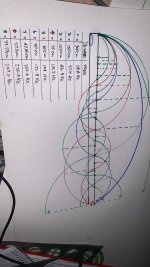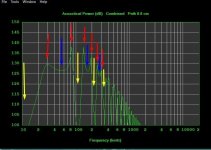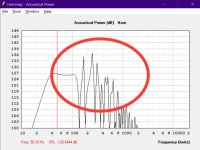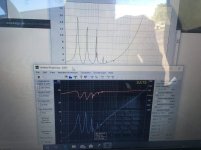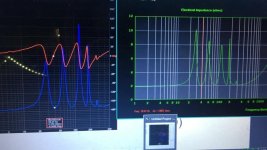SUBwoofers, not audiophile or Pro Audio 50hz bass bin.I give up on Mr BandPass. He keeps making silly assumptions.
Seems to be where he is getting lost… he does not really understand the physics.
What is the frequency range of the QW boxes you build?
dave
What physics are there to know when I can PHYSICALLY see the difference between
THIS
THAT
????
I PHYSICALLY have to use a different function in HR to model a TL than a TH.
There are multiple TH functions in HR due to the PHYSICAL location of the TAP is critical to getting the rear wave and front wave of driver to work as 1 output in series tuned 6th order enclosure.
I can use the EXACT SAME function AND inputs in HR to model a standard BR enclosure and Coupling Chamber TL enclosure. The 2 enclosure are PHYSICALLY the same enclosure.
TL doesn't stand for TAPPED line.
TH doesn't stand for TRANSMISSION horn.
BR = 2nd order enclosure.
TL = 2nd order enclosure.
TH = 6th order enclosure.
Do you PHYSICALLY get that?
Tapped pipes or TL with the driver inputs at both ends are easy to figure out with pen and paper @ 1/4 wavelength parts of resonances and cancelation freqs that ‘fit’) or horn response for the appropriate length and csa to make a decent subwoofer.
the ‘TL‘ with exit and driver front output seperated merely dilutes this I think ? (Path in horn response)
the front and back wave dont have any choice but to work together at resonace (90 degrees off driver motion) or cancelation (180 out of phase) Or neither (in phase) ?
Fb x2,3,4,5,6,7,8,9…, Like a musical instrument or even some antenas? Measure the exit with a microphone (or both) and it’s the same stuff(or try and line up the driver tap from the start to cancel out the second resonance like the orange graph in the REW graph(I came up short on the dark green))
the ‘TL‘ with exit and driver front output seperated merely dilutes this I think ? (Path in horn response)
the front and back wave dont have any choice but to work together at resonace (90 degrees off driver motion) or cancelation (180 out of phase) Or neither (in phase) ?
Fb x2,3,4,5,6,7,8,9…, Like a musical instrument or even some antenas? Measure the exit with a microphone (or both) and it’s the same stuff(or try and line up the driver tap from the start to cancel out the second resonance like the orange graph in the REW graph(I came up short on the dark green))
Attachments
Last edited:
Talk is cheap.
Here are the PHYSICS.
A TL is a 2nd order BR enclosure with a fancy (positive, straight, or negative flare) port.
Both enclosures will look EXACTLY the same internally and externally.
I rest my case.





Here are the PHYSICS.
A TL is a 2nd order BR enclosure with a fancy (positive, straight, or negative flare) port.
Both enclosures will look EXACTLY the same internally and externally.
I rest my case.
All you did was stretch a BR box out until pipe resonances and 4/4 cancelation freqs started forming and it’s now a ‘TL’ as a result ?Talk is cheap.
Here are the PHYSICS.
A TL is a 2nd order BR enclosure with a fancy (positive, straight, or negative flare) port.
Both enclosures will look EXACTLY the same internally and externally.
I rest my case.
SUBwoofers
So you don’t have to worry about HF extention and are XOing the ugly stuff at the top end out of the way.
Quantity instead of quality?
dave
Last edited:
i dunno when its a bass reflex and when its a 'TL'?
There is a range where you can have a hybrid. the lines are squishy.
dave
The 45 cm 1/4 wave (3/4) closed pipe resonance in the ‘TL’ becomes a 90 cm open pipe resonance in the BR ? (Or am I overthinking)
but sir, The ‘bandpass’ part lost the battle with pipe resonance and funk 🤷♂️. You ever hear this stuff Or study it? It sounds goofy as heck and rings …
What SUBwoofer do you listen to WITHOUT a low pass filter?
My low pass filters are usually set between 80-120hz.
Funk is all I listen to. Funk was sampled in old school Hip Hop with the Emu SP1200 or Akia MPC60. The bass usually came from the Roland TR-808 with a DECAY feature. See James Brown, George Clinton, FUNKadelic, etc.
For you bass guitarists, Outkast and Too Short used the actual instrument.
All you did was stretch a BR box out until pipe resonances and 4/4 cancelation freqs started forming and it’s now a ‘TL’ as a result ?
Like I said before, they are the same 2nd order enclosure. Hence,
The Coupling Chamber picture puts the icing on the cake.
View attachment 1283554
View attachment 1283556
what are these? bass reflex boxes with funny standing waves?
The 1st model is a BR.
The 2nd model is a negative flare TL.
If you were trying to compare a BR to TL, then use the Nd function for the BR and OD function for the TL. Make sure they are the same volume and they both have the same cross section area.
There is a range where you can have a hybrid. the lines are squishy.
dave
Because they are both 2nd order enclosures!
BP4 & FLH are 4th order enclosures.
TH, Keystone, Paraflex, THAM, ROAR, T-TQWT, TappedQWP, and Devastator are 6th order enclosures.
Devastator = BP6Parallel tune.
The other 7 = BP6Series tune.
K.I.S.S!
So you don’t have to worry about HF extention and are XOing the ugly stuff at the top end out of the way.
Quantity instead of quality?
dave
Low distortion and minimum cone movement in the ACTUAL listening range are quality to me. Mids and highs are for 80hz on up.
I really don't care what happens above 100hz when modeling a SUBwoofer. Anything after that can be tuned out with DSP, EQ, or higher order low pass filter. And, I KNOW all you Pro Audio folks use all that magic on simple BR enclosures. The same filtering principles can be applied to bandpass enclosures.
This is a SUBwoofer thread, not a MID bass or MID range thread.
The 45 cm 1/4 wave (3/4) closed pipe resonance in the ‘TL’ becomes a 90 cm open pipe resonance in the BR ? (Or am I overthinking)
Well...I did say K.I.S.S.
I go on what I see and hear. If it looks like a duck and quacks like duck, then it's a duck. BR's and TL's are the same duck.
I don't care about closed/open pipe resonances, eigenmodes, or the crazy mathematics behind these modeling programs.
If you can understand a Tuba or a cheerleader horn, then you should understand how to get LOUD and CLEAR.
Lungs = rear chamber.
Larynx = driver.
Inside mouth = compression chamber.
Cheerleader horn = positive flare port.
Our bodies are BP6S!
I trust what spits out of HR. It's the best gift to a basshead like me.
A direct radiator enclosure cannot compare to the clean effortless low distortion bass that comes out of bandpass enclosure. See Tom Danley.
Also, air pumps or engines are BP6P's.
It's a bandpass world.
A direct radiator is only good cooling and heating.
It's a bandpass world.
A direct radiator is only good cooling and heating.
I like to measure my boxes instead of give them funny names and ‘orders’. What ‘orders’ are these And what are they called?Because they are both 2nd order enclosures!
BP4 & FLH are 4th order enclosures.
TH, Keystone, Paraflex, THAM, ROAR, T-TQWT, TappedQWP, and Devastator are 6th order enclosures.
Devastator = BP6Parallel tune.
The other 7 = BP6Series tune.
K.I.S.S!
Attachments
- Home
- Loudspeakers
- Subwoofers
- Theoretically best subwoofer enclosure
